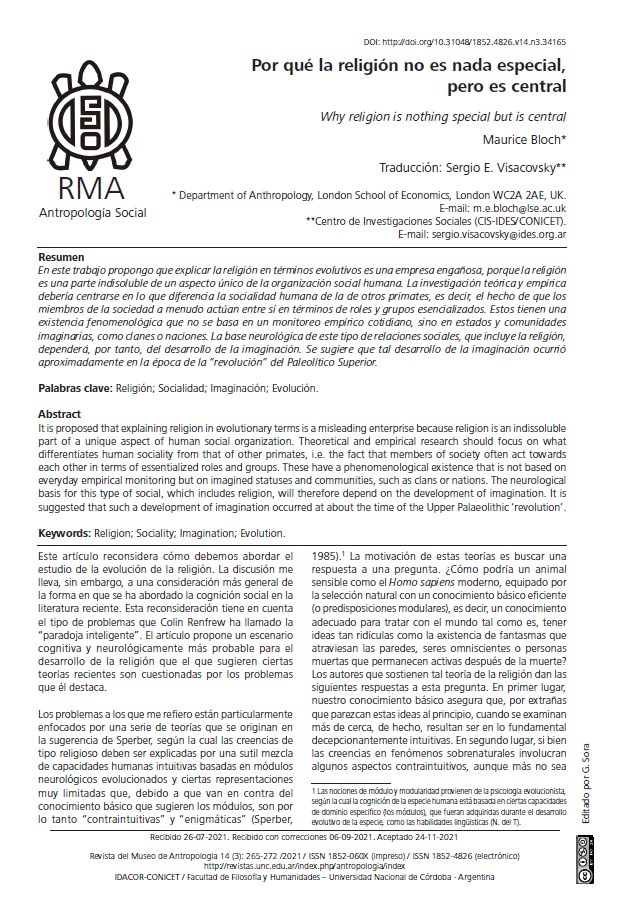Por qué la religión no es nada especial, pero es central
DOI:
https://doi.org/10.31048/1852.4826.v14.n3.34165Palabras clave:
Religión, Socialidad, Imaginación, EvoluciónResumen
En este trabajo propongo que explicar la religión en términos evolutivos es una empresa engañosa, porque la religión es una parte indisoluble de un aspecto único de la organización social humana. La investigación teórica y empírica debería centrarse en lo que diferencia la socialidad humana de la de otros primates, es decir, el hecho de que los miembros de la sociedad a menudo actúan entre sí en términos de roles y grupos esencializados. Estos tienen una existencia fenomenológica que no se basa en un monitoreo empírico cotidiano, sino en estados y comunidades imaginarias, como clanes o naciones. La base neurológica de este tipo de relaciones sociales, que incluye la religión, dependerá, por tanto, del desarrollo de la imaginación. Se sugiere que tal desarrollo de la imaginación ocurrió aproximadamente en la época de la “revolución” del Paleolítico Superior.
Descargas
Referencias
Andersen, Benedict. (1983) Imagined communities: reflections on the origin and the spread of nationalism. London, UK: Verso.
Barrett, Justin L. (2004) Why would anyone believe in god? Walnut Creek, CA: Alta Mira Press.
Beard, Mary, John North y Simon Price. (1998) Religions of Rome, vol. 2. Cambridge, UK: Cambridge University Press.
Bloch, Maurice. (1986) From blessing to violence: history and ideology in the circumcision ritual of the Merina of Madagascar. Cambridge, UK: Cambridge University Press.
Bloch, Maurice. (1995) “The symbolism of tombs and houses in Austronesian societies with reference to two Malagasy cases”. Austronesian Studies August: 1–26.
Boyer, Pascal. (1994) The naturalness of religious ideas: a cognitive theory of religion. Berkeley, CA: University of California Press.
Boyer, Pascal. (2001) Religion explained: the evolutionary origins of religious thought. New York, NY: Basic Books.
De Waal, Frans. (2000) Chimpanzee politics: power and sex among apes. Baltimore, MD: Johns Hopkins University Press.
Dunbar, Robin. (2004) The human story. London, UK: Faber and Faber.
Evans-Pritchard, Edward Evan. (1948) The divine kingship of the Shilluk of the Nilotic Sudan. Cambridge, UK: Cambridge University Press.
Feeley-Harnik, Gillian. (1991) The green estate: restoring independence in Madagascar. Washington, DC: Smithsonian Institution Press.
Fuller, Christopher John. (1992) The camphor flame: popular Hinduism and society in India. Princeton, NJ: Princeton University Press.
Frankfort, Henri. (1948) Kingship and the gods. Chicago, IL: Chicago University Press.
Harris, Paul L. (2000) The work of the imagination: understanding children’s world. Oxford, UK: Blackwell.
Kopytoff, Igor. (1971) “Ancestors as elders”. Africa 41: 129–142.
Middelton, John. (1960) Lugbara religion. London, UK: Oxford University Press.
Nelson, Janet L. (1987) “The Lord’s anointed or the people’s choice: Carolingian royal rituals”. Cannadine, David y Simon Price (eds.) Rituals of royalty: power and ceremonial in traditional societies (pp. 137–180). Cambridge, UK: Cambridge University Press.
Pyysiainen, Ilkka. (2001) How religion works. Leiden, The Netherlands: Brill.
Radcliffe-Brown, Alfred Reginald. (1952) Structure and function in primitive society. London, UK: Cohen and West.
Rakoczy, Hannes. (2007) “Play, games and the development of collective intentionality”. Kalish, Charles W. y Mark A. Sabbagh (eds.) Conventionality in cognitive development: how children acquire representations in language thought and action (pp. 53–67). New directions in child and adolescent development, no. 115. San Francisco: Jossey-Bass.
Smith, Jonathan Z. (1982) Imagining religion: from Babylon to Jonestown. Chicago, IL: University of Chicago Press.
Sperber, Dan. (1985) “Anthropology and psychology: towards an epidemiology of representations”. Man (N.S.) 20: 73–89.
Wengrow, David. (2006) The archaeology of early Egypt. Social transformations in north-east Africa, 10,000–2,650 BC. Cambridge, UK: Cambridge University Press.

Descargas
Publicado
Número
Sección
Licencia
Derechos de autor 2021 Sergio Visaconvsky

Esta obra está bajo una licencia internacional Creative Commons Atribución-NoComercial-CompartirIgual 4.0.
Aquellos autores/as que tengan publicaciones con esta revista, aceptan los términos siguientes:
- Los autores/as conservarán sus derechos de autor y garantizarán a la revista el derecho de primera publicación de su obra, el cual estará simultáneamente sujeto a la Licencia de reconocimiento de Creative Commons que permite a terceros compartir la obra siempre que se indique su autor y su primera publicación en esta revista.
- Los autores/as podrán adoptar otros acuerdos de licencia no exclusiva de distribución de la versión de la obra publicada (p. ej.: depositarla en un archivo telemático institucional o publicarla en un volumen monográfico) siempre que se indique la publicación inicial en esta revista.
- Se permite y recomienda a los autores/as difundir su obra a través de Internet (p. ej.: en archivos telemáticos institucionales o en su página web) antes y durante el proceso de envío, lo cual puede producir intercambios interesantes y aumentar las citas de la obra publicada. (Véase El efecto del acceso abierto).













